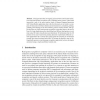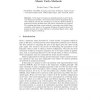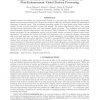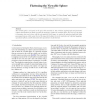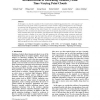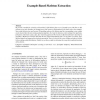114
Voted
AMDO
2008
Springer
15 years 2 months ago
2008
Springer
Abstract. This paper describes our ongoing research work on deviceless interaction using hand gesture recognition with a calibrated stereo system. Video-based interaction is one of...
139
Voted
AMDO
2008
Springer
15 years 2 months ago
2008
Springer
Abstract. In this paper we present our work on markerless model-based 3D human motion capture using multiple cameras. We use an industry proven anthropometric human model that was ...
128
click to vote
AMDO
2008
Springer
15 years 2 months ago
2008
Springer
Abstract. In this paper we propose an original approach to solve the Inverse Kinematics problem. Our framework is based on Sequential Monte Carlo Methods and has the advantage to a...
94
Voted
SPIEVIP
2008
15 years 2 months ago
2008
Adaptive methods are defined and experimentally studied for a two-scale edge detection process that mimics human visual perception of edges and is inspired by the parvo-cellular (...
123
click to vote
SCA
2007
15 years 2 months ago
2007
We propose a flexible geometric algorithm for placing arbitrary cracks and incisions on tetrahedralized deformable objects. Although techniques based on remeshing can also accomm...
89
Voted
CAE
2007
15 years 2 months ago
2007
The viewable sphere corresponds to the space that surrounds us. The evolution of photography and panoramic software and hardware has made it possible for anybody to capture the vi...
149
click to vote
VISSYM
2007
15 years 2 months ago
2007
The dataset generated by a large-scale numerical simulation may include thousands of timesteps and hundreds of variables describing different aspects of the modeled physical pheno...
148
Voted
SGP
2007
15 years 2 months ago
2007
Geometric flows are ubiquitous in mesh processing. Curve and surface evolutions based on functional minimization have been used in the context of surface diffusion, denoising, sha...
125
click to vote
SGP
2007
15 years 2 months ago
2007
In this paper, we describe a system for the reconstruction of deforming geometry from a time sequence of unstructured, noisy point clouds, as produced by recent real-time range sc...
121
Voted
SGP
2007
15 years 2 months ago
2007
We present a method for extracting a hierarchical, rigid skeleton from a set of example poses. We then use this skeleton to not only reproduce the example poses, but create new de...
